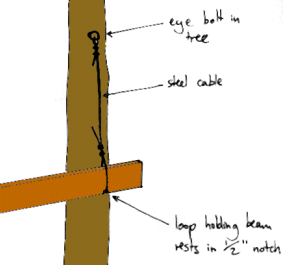Types of support | Flexible supports | Rigid framed supports | Fixtures and fastenings | Metal brackets | Cables
Knee braces | Dangerous things to avoid | Non-flat surfaces | Improving stability | Building without trees
Flexible supports
Flexible joints allow the tree to move relative to the treehouse and are used in instances where more than one point will hold up a horizontal support, for example between two trees. Motion in trees from the wind can generate incredible power due to the action of leverage lower down the tree trunk. This results in small relative motions of huge strength which can spell disaster for a poorly designed treehouse support network.
Generally one end of a support is permanently fixed to the tree and the other moves in a flexible support. This gets more complicated as the number of supports increases. You may consider allowing the floor joist system to 'float' as an independent unit on the main supports, allowing an added degree of flexibility. The joist system is created as one rigid unit, fixed at one point, with guides and runners used to retain the correct position and security of the joists. There are two main types of flexible support; metal brackets and cables.
Metal brackets

Brackets are usually custom made for a treehouse along the lines of a channel within which the support beam can rest and slide. Motion is normally possible in only one direction. For example, a beam running north-south (see diagram to right) will only be able to slide north or south, and is restricted from moving west or east or up or down.
As a point of interest, the beam itself will not necessarily slide over the bracket. The tree bearing the bracket may move under the beam instead. In this case the beam would remain stationary relative to the ground but would appear to move relative to the tree with the bracket. Also important is that if the tree moves west or east it will carry the beam with it, and this movement will have to be accounted for elsewhere in the support system.
Brackets should be made from at least ¼" steel welded together. There should only be one bolt to avoid compartment problems in the tree. Position the hole so that when the bracket is attached to the tree there is still space for the beam to be inserted. Some bracket designs don't use bolts at all and can be quite complicated, but keeping things simple keeps fabrication costs down. A metal plate should be fitted to the underside of the beam so the moving surface is metal-metal. This avoids damage to the beam which would otherwise wear down as it slides over the bracket.
More on fitting metal brackets including some design examples.
Cable/suspended attachment

Steel cables are already used worldwide in tree surgery to support limbs that might otherwise collapse. There are many types of fitting and cable that can be readily adapted for use in treehouse support situations.
The main advantage of using cables is their range of motion. A beam can move north, south, east and west without any resistance. A slight arc is inevitable in this motion, raising the floor level slightly, but if a cable length of 4 feet or more is used, the effect on how level the platform is becomes negligible. A cable may be used to supplement the strength of a long span, in which case it will be a fixed joint. Cables are also cheaper than brackets and the parts are easily available without too much planning. Here are some awkward situations where cables are useful:
- A curving or angled trunk/branch that is hard to bolt a beam directly on to.
- Part of the platform extends too far out from the tree to be supported easily with wooden knee braces.
- Knee braces under the house are visually obtrusive or are intruding on useful space at the base of the tree.
- The trees involved move around a lot (more than 12" relative to each other).
More on fitting cables.
Types of support | Flexible supports | Rigid framed supports | Fixtures and fastenings | Metal brackets | Cables
Knee braces | Dangerous things to avoid | Non-flat surfaces | Improving stability | Building without trees
